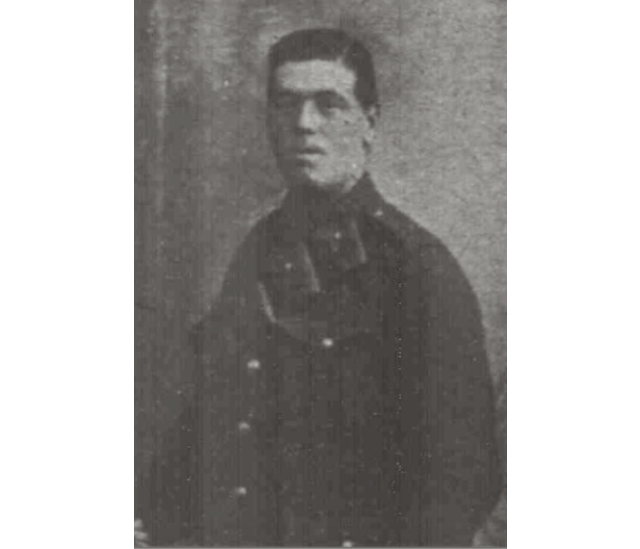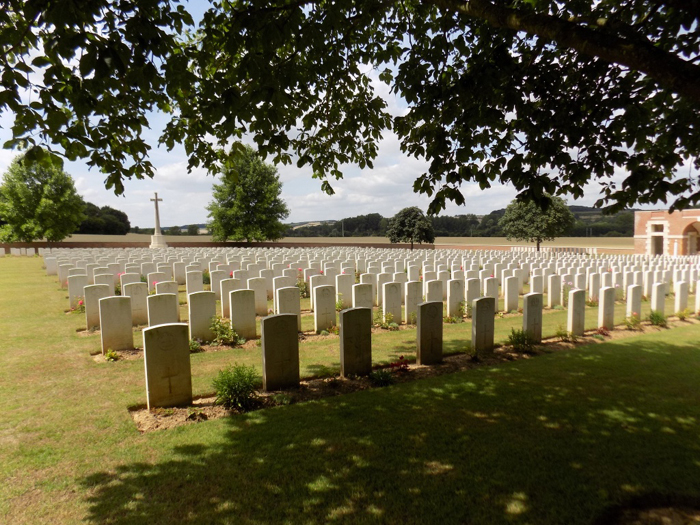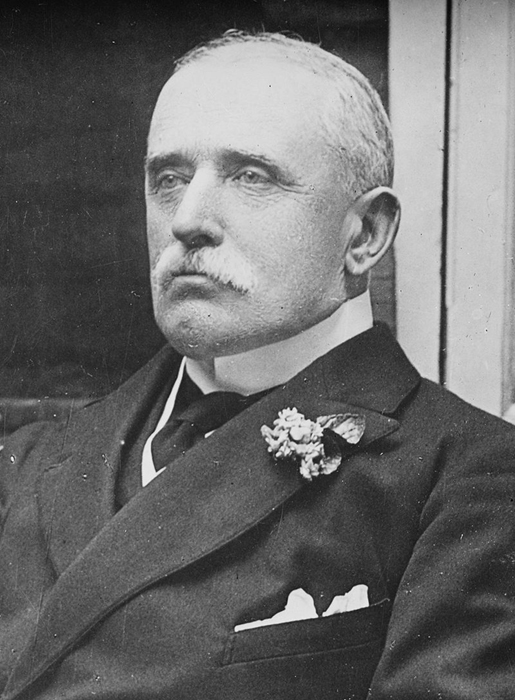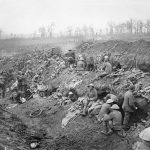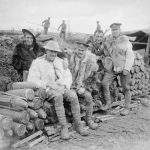Milton ‘petit’ Wood was the youngest brother of my great, great grandmother Alice Mary Eldridge (née Wood), making him my great, great grand uncle from my mother’s father’s mother’s side, and he served in the First World War.
More than two-dozen young men were sent to fight for monarch and country from both my mother and my father’s side of my family. Even though the odds were high, Milton was the only soldier to die in action from our entire bloodline across the centuries – from Naval men, the Boer War, WW1 to WW2.
Milton’s story both fascinates and saddens me. I’m particularly keen for him to be remembered, especially as he died in such tragic circumstances. The further irony if you can call it that, is that Milton ‘petit’ Wood was wounded in an area called ‘Bazentin – Petit Wood’ during The Battle of the Somme. He died at Heilly Clearing Hospital from his wounds on the 26th August 1916.
Milton is buried at Heilly Station Cemetery, Merricourt l’abbe, alongside 9 of his fellow men from The Royal Sussex Regiment, 2nd Battalion who also fell during the Somme. Even more tragic is that Milton also lost his friend and next-door neighbour, Edwin Charles Waite, also part of the 2nd Battalion during The First Battle of Ypres on the 13 November 1914. They were both 27 when they were killed. Unfortunately, Milton’s service records are missing so I have had to piece together what I can from other historical records to relay this important piece of my family’s history.
Milton’s and Edwin’s names are inscribed for eternity upon the War Memorial, along Bexhill seafront – a regular meeting place for my friends and I after school exactly 80 years after WW1 begun. I had no idea that one of my relatives was one of these faceless names, sacrificed in The Great War. I didn’t even know I had family from Bexhill, I went to school there for a few years but really I grew up in London, Cornwall via Hertfordshire.
It took some corralling for Mayor George Herbert Gray to actually get the War Memorial erected. He placed an urgent appeal within the Bexhill Observer in November 1919 calling upon those who were not yet ‘alive to their moral responsibility’ to give to Bexhill War Memorial Fund. It’s not that Bexhillians were not ‘patriotic’ indeed they did a great deal for those at the front. One particular touching story I read was how they rallied around and made sure every child of every soldier fighting in the war had a stocking for Christmas. It’s hard to say what the mood was in 1919, but perhaps immediately after the Armistice, people wanted to forget the war, the sheer devastation it caused and move on? You can hardly blame them.
Early life and recruitment
Milton was born in 1888, in Silverdale Cottage, Hollington. Susan Wood (nee Hutcheson), Milton’s mother, my great, great, great grandmother was 45 when she gave birth to her last child. She named him after her brother, Milton Hutcheson who had died some years before and as fate would have it, also at a young age. Milton’s grandmother, Susan’s mother, Hannah Beeching and great grandmother Mary Dodds originally came from Fermanagh, Ireland, ending up somehow in landlocked Ashburnham in around 1819. Milton’s father, my great, great, great grandfather David Wood continued to work as a farm labourer way into his late sixties, as did Susan who worked as a Laundress. His family came from Wartling, yet another tiny village in the Sussex Weald.
Alice and Milton came from a large family. David and Susan had 13 children in total, 5 boys and 8 girls. As Milton was the youngest of all the Woods, all his other siblings had flown the nest so he grew up in rural Mountfield with his aging parents and his younger cousin Daisy Hutcheson for companionship. The age difference between Milton and Alice my great, great grandmother was 20 years. By the time Milton was two, Alice had already married, my great, great grandfather William Eldridge in Hastings.
Like most young boys in rural Sussex, Milton left education at 12 and was sent to work as a farm hand. By then his parents had moved to the outskirts of Bexhill, Mayo Farm. I’m sure it must have been quite exciting for him to go into Bexhill Town, he would have been about 14 when the 8th Earl De La Warr organised Britain’s first motor race along the seafront in May 1902. Thousands flocked to the town to see the spectacle.
No doubt growing up in the countryside, helped Milton to quickly acclimatise to ‘bivouacking’ – the setting up of temporary camp’s in rural France and Belgium when fighting in WW1. This must have been so much more of an alien experience to young soldiers from the inner city slums who had probably never even been to the countryside before.
Milton’s other brothers were also service men of sorts. David Samuel Wood worked for Bexhill Council, Henry James Wood was a Carter and Alfred George, six years older than Milton also joined the British Army as a Gunner in The Royal Sussex Battery. Alfred George taught signalling in both Mesopotamia (Iraq) and India during WW1. However, Milton remained a Private, whilst Alfred moved up the ranks within the Artillery, becoming a Sergeant Major, serving for 12 years all in all.
When Milton decided to join the Army in Hastings in his mid-teens, he still lived with his parents at 14 North Road in Sidley. There was only 5 months difference in age between Edwin who lived next door at number 15, so I wonder if Milton and Edwin spurred each other on and joined up together at the same time?
In 1913 two major events happened in Milton’s life, he married Rosey Bourner a girl from Westfield. They had a daughter called Doris and lived at 4 Sprays Cottages in Sidley. Two months after marrying Rose, his father David Wood, my great, great, great grandfather passed away.
Rose and Milton had been wed just over a year when WW1 broke out, by then Milton had been a soldier for almost 10 years. His daughter Doris was only seven months old when Milton left for France and nearly two when he died. As his army service records are missing, I have no idea if he was ever granted leave to return home to see his wife and daughter again before his life was unceremoniously cut short.
Initial service in France
Milton was part of the initial 80,000 soldiers of the British Expeditionary Force, the 1st Army that was sent to help the French and the Belgians against the invading Germans. Leaving England behind them for the Western Front as early as August 1914, they thought they would win the war within a matter of months and be back home in time for Christmas. The Royal Sussex Regiment, 2nd Battalion sailed from Southampton to Le Havre on the 12th August and ‘received a very friendly spirit by the French public’.
Within the first few weeks of landing, his Battalion suffered a few initial casualties not at the hands of the Bosche, but from the Les Bonhommes (the French) who mistakenly opened fire on their carriages. Nearby Maubeuge they witnessed from afar the German’s reigning down their hell and fury upon Mons. Thousands died on both sides. Thomas Highgate, aged 19 upon witnessing the militarised slaughter of his fellow men, fled. He was caught, tried and shot. Thomas was the first British soldier to be executed for desertion, now thankfully pardoned.
On the retreat from Mons, Milton’s battalion luckily escaped relatively unscathed and had the good luck of stumbling upon a deserted farmhouse in Favril stocked full of kegs of beer and cheese, which could have well been a German horde. What is most perplexing about reading his battalion’s early movements in their War Diary is that they were always ‘on the move’, marching between 5 to 20 miles most days on dusty country roads or cobbled village streets, billeted somewhere different almost every night. You have to wonder what was Field Marshall John French’s strategy? In fact, one day they reportedly marched 17 ½ hours without drawing rations, which must have been utterly exhausting. I’m sure even our modern day marines would find their itinerary gruelling, plus living off a peculiar diet of rum, jam, bread and corned beef.
Despite it all the 1st Army still had a good sense of humour, referring to themselves as the PBI, “The poor bloody infantry” or as “something to hang things on”. Foot soldiers backpacks and equipment might weigh nearly half of the soldier’s own bodyweight. Within one month, the Battalion had trekked around Northern France, over to Belgium, then back down towards Paris, experiencing only a few surprise skirmishes here and there. It was when they were circling back on themselves east of Paris towards the river Marne that they experienced days and days of heavy casualties due to what was described as a lack of reconnaissance, with literally only haystacks and trees for cover under heavy machine gun fire and artillery until they managed to occupy the ridge at Troydon (The Battle of Aisne).
By then the Germans had brought out the big guns, named the “Bolo’s” described in the War Diary as “Monster high explosive shells”. It was around this time that Milton’s friend Edwin had been wounded and sent to the base hospital. Unfortunately for Edwin, he was deemed fit enough and returned to the front line on the 12th November. The 2nd Battalion had now been ‘dug in’ for almost three weeks in woodlands, one spot called ‘Pig Sty Wood’, situated just outside of Ypres – which the Tommies affectionately called Wipers.
Here the entries in the 2nd Battalion’s war diary get longer. To think they were sent ‘over the top’ to No Man’s Land without helmets and just their Bayonets against intense Machine gun fire is utter folly. They were lambs to the slaughter. It wasn’t actually until the 8th April 1916, 18 months into the war that the 2nd Battalion were all issued with metal helmets.
Edwin was apparently wounded once more and whilst being carried to safety by a French soldier, they were both shot, by a German sniper. Edwin’s grave was never found, but his name is also immortalised on the Ypres Menin Gate Memorial. Eldred, Edwin’s older brother also died at the front in Rouen, 1918 from gas poisoning. A nurse wrote to his mother and father ‘Everything possible was done for him, he was so good and brave’.
Trench warfare
The 2nd Batallion arrived at Hazebrouck on the 19th November in a blizzard where they remained in relative comfort and safety for one month, restocking and retraining in telephony, bomb making, and machine gun operation. Some officers were allowed 96 hours leave back to England, whilst the rest stayed behind and were inspected on parade by Field Marshall French and ‘thanked for work done’. On the 3rd of December, the King, George V arrived to meet the troops. Kaiser Wilhelm must have had intelligence that his cousin, the British King had arrived as two days later the Germans flew over and dropped bombs on Hazebrouck.
On the 21st December, they marched out towards Bethune and recaptured a British trench at Quinque Rue, with the help the Northants and an Indian Battalion. It is estimated that almost 75,000 Indians, gave their lives fighting for the British in WW1. It’s also interesting the lasting impact Indians had on the British language during this period. Who knew for example that ‘Blighty’ in Urdu means foreign and the word ‘cushy’ comes from the Hindi word meaning ‘pleasure’.
Christmas Day for the 2nd Battalion was spent in relative peace. There are numerous stories that exist about an unofficial truce amongst the foot soldiers in the trenches on the Western Front, who adopted a ‘live and let live’ mentality, but of course, we all know this was short lived as the war dragged on for 3 more years.
Between Christmas Eve 1914 and the early part of the New year, 180 men were taken to hospital with Ague, swollen feet, and Rheumatism, due to the poor conditions of the trenches and no doubt where the term ‘trench foot’ was coined. One company had to wait, waist high in water overnight, until they were relieved. It wasn’t until the end of January that the battalion could bathe properly. I can’t imagine the stench and filth. The French soldiers called themselves ‘Poilu’ which meant ‘Hairy’.
Both sides had reached a stalemate. Literally, neither side was making any inroads. Each coming up with new and creative ways to destroy each other’s trenches to force them out into the open. Sappers now appeared on the scene. Mines were dug deep underneath each other’s trenches and blown to smithereens.
January was spent protecting The Keep, with the Northants regiment and received a special thanks from the Brigade Major for their courageousness under heavy fire. The 2nd Battalion must have grown quite close to Northamptonshire and the Loyal North Lancashire regiments as for nearly a whole year, they fought side by side.
The vast majority of 1915, was spent manning a 10km front between Cambrin and Bethune. Their days slipped into daily routine and repetition; heavy shelling, fixing communication trenches, repairing breastwork and barbed wire, wounded men coming and going, occasional assaults on the enemy line resulting in more tragic casualties. Although, their time was occasionally interspersed with moments of rest and relaxation, at Bethune. Bathing, of course, was a real luxury as was being able to swim and play football.
By the end of September, new objectives were received by Lieutenant Colonel Evelyn Villiers to attack the german line. In this attack, most of the Royal Sussex Machine Gunners were ‘annihilated’. What remained of the Battalion, now moved to the frontline at what became The Battle of Loos. They remained in action for almost three months in an area, just south west of Lille. One of their commanding officer’s Major Terry was hit by a shell and died on the 1st Oct.
Milton’s second Christmas on the Western Front was spent in the firing line and did not get to celebrate the festivities until the New Year when his Battalion were sent to reserve at a small French village, called Philosophe. They remained on constant gas alert and paying close attention to which way the wind was blowing. They also received a lecture from the Anti-Gas School.
Death at the Somme
It was said that the intense 7-day bombardment from the 18 pounders and Howitzers during the beginning of The Battle of the Somme could be heard in Sussex and even as far away as London. The British lost 19,240 men on just one day, it was a total disaster.
- Troops outside their dug-outs in Bazentin-le-Petit, July 1916. – Image Courtesy of the Imperial War Museum (IWM Q 4014)
- Royal Artillery gunners wearing sheep-skin coats, Bazentin-le-Petit, November 1916. – Image Courtesy of the Imperial War Museum (IWM Q 4473)
Milton’s troop were in training at the beginning of July, getting ready for the next sequence of the campaign and had moved away from their second home at Bethune, southwards towards Albert. On the 14th of July, Milton’s 2nd Battalion successfully captured three villages; Longueval, Bazentin le petit and Bazentin Le Grand. It was here that Milton was fatally wounded and where his story draws to a close. He was taken to the Heilly Station Hospital and died of his wounds five weeks later, on the 26th August 1916, just over 100 years ago.
Lest we not forget, that there’s some corner of a foreign field, that will always be England.
The story was submitted by Lucie Balcombe

